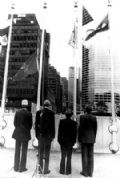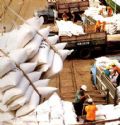|
|

Heating days
in Hanoi, August 1945.

In the first
days against the French colonialists
in Ben Tre, Southern
Vietnam.

Using bicycles to carry
commodities to Dien Bien Phu Campaign.

The liberation army breaking
through the gate of the Independence Palace in Saigon (April 30,
1975).

The ceremony to hoist Vietnamese
national flag at the UN Headquarter in New York (Sept. 1977).

Bim Son Cement Plant in Thanh Hoa
Province.

Hoa Binh Hydro-electric Power
Plant.

Making garments for
export.

Dong Thap Polytechnic Hospital has
been upgraded.

Rice for export at Haiphong
Port.

The Ancestors' Death Anniversary
held at Hung King Temple (2000).

Vietnam hopes
to welcome 3.5 - 4 million foreign tourists in
2005.
nbsp; | On February 3, 1930 in
Jiulong (Xianggang, China), Nguyen Ai Quoc (President Ho Chi Minh), the
representative of the Communist International, presided over a conference
to merge various communist organizations and found the Communist Party of
Vietnam.
From October
14-31, 1930, the first plenum of the Party Central Committee was convened
in Xianggang-China that decided to rename the Communist Party of Vietnam
as the Indochinese Communist Party.
The First National Party
Congress(March 27-31, 1935 in
Macao, China)
The Indochinese
people’s sole way to liberate themselves is only the way of army struggle
by the mass.
The Congress, convened from
August 13-15, 1945 in Tan Trao (Tuyen Quang), called upon the entire
people to stand up in a general uprising to gain power. On August 28, 1945
the August Revolution won victory. On September 2, 1945, President Ho Chi
Minh read the Declaration of Independence at Ba Dinh Square in Hanoi,
proclaiming the birth of the Democratic Republic of Vietnam. On November
11, 1945, the Party announced to dissolve itself but in fact, it withdrew
into underground activities.
The 2nd National
Party Congress (February 11-19, 1951 in Tuyen Quang
Province) The
Congress of resistance war
Attending the Congress, there
were 158 official delegates and 53 alternate delegates representing
766,349 Party members. The Congress decided to bring the Party into open
activities under a new name as the Vietnam Workers’ Party, and adopted the
new Political Platform, Declaration and Statute.
The 3rd National
Party Congress (September 5-10, 1960 in Hanoi)
The Congress of
socialist construction in the North and struggle for peace and
reunification of the country
The Congress was attended by
525 official delegates and 51 alternate delegates, representing more than
500,000 Party members in the whole country, and 20 international
delegations. The Congress determined two revolutionary strategies in two
zones, the North and the South.
The 4th National
Party Congress (December 14-20, 1976 in Hanoi)
The Congress of complete
victory of the national liberation cause; the Congress for summing up
major lessons of the anti-US resistance war for national salvation; the
Congress of national unification taking the whole country forward on the
socialist path.
1,008 delegates representing
more than 1,550,000 Party members and 29 international delegations
participated in the Congress. The Congress elected the 4th
Party Central Committee, comprising 101 official members and 32 alternate
members, which elected the Political Bureau including 14 official members
and three alternate members. The Congress decided to rename the Vietnam
Workers’ Party as the Communist Party of Vietnam.
The 5th National
Party Congress (January 27-31, 1982 in Hanoi) All for the socialist Fatherland, for the
happiness of the people
1,033 delegates representing
1,727,000 Party members and 47 international delegations attended the
Congress. The Congress elected the 5th Party Central Committee,
comprising 116 official members and 36 alternate members. The Congress
affirmed to continue renewing the mechanism of economic management,
acknowledged the de-facto existence of many economic sectors, adjusted the
steps and scale of the process of socialist industrialization and
considered agriculture the first and foremost front.
The 6th National
Party Congress (December 15-18, 1986 in Hanoi) The Congress of succession and resolve for
renewal, unity to advance forward
1,129 delegate representing 1.9
million of Party members in the whole country, 35 international
delegations and nearly 100 guests participated in the Congress. The
Congress defined the line of renewal and initiative the process of renewal
in Vietnam under the Party’s leadership. The Congress elected the
6th Party Central Committee, comprising 124 official members
and 49 alternate members.
The 7th National
Party Congress (June 24-27, 1991 in Hanoi) The Congress of intelligence – renewal -
democracy – discipline - unity
Attending the Congress there
were 1,176 delegates representing more than 2 million Party members in the
whole country and many international delegations.
The Congress elected the
7th Party Central Committee, comprising 146 members. The
Congress approved the political programme for national construction during
the transition to socialism and the strategy on socio-economic stability
and development to the year 2000. The Congress decided to pursue the
open-door foreign policy, thereby “Vietnam wishes to befriend all
countries in the world community, striving for peace, independence and
development.”
The 8th National Party Congress (June 28 - July 1, 1996 in
Hanoi)
Continuing to carry on the
cause of renewal, step up industrialization and modernization for the
target of a rich people, a strong country, an equitable and civilized
society, steadfastly advancing towards socialism.
The Congress was held with the
participation of 1,198 delegates representing more than 2 million Party
members and nearly 40 international delegations. Evaluating 10 years of
renewal, the Congress affirmed: “The cause of renewal over the past ten
years has attained great achievements of very important significance”.
“The path towards socialism in our country has been determined more
clearly.” The Congress elected the 8th Party Central
Committee including 170 members.
The 9th National
Party Congress (April 19-22, 2001 in Hanoi) The Congress of intelligence, democracy,
solidarity and renewal
Attending the Congress were
1,168 delegates, symbolizing intelligence, political spirit and solidarity
power of the Party, and 34 international delegations. The Congress
approved the “Strategy on 2001-2010 socio-economic development” and
“Directions, tasks and plans for the 5-year socio-economic development
(2001-2005)”. The Congress elected the 9th Party Central
Committee, comprising 150 members.
From the 9th
National Party Congress to January 2005, 11 plenums of the Party Central
Committee were convened that adopted many important resolutions on
political, socio-economic issues of the country and prepared for the
10th National Party Congress to be held in the second quarter
of 2006.
Compiled
by Vuong
Mo |